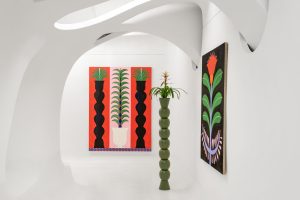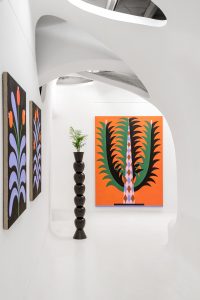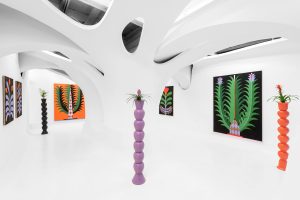Until 28th May, with Of My Abstract Gardening, by Agostino Iacurci, the colors of a fascinating garden invade Galleria Ex Elettrofonica. Below, the results of the pleasant chat that the artist has kindly granted to Juliet Art Magazine.
Claudia Pansera: I like to start interviews with a question that is a bit of a ritual… An Italian artist, born in Foggia, who travels a lot. Who is Agostino Iacurci?
Agostino Iacurci: I might add that I am thirty-six years old, I studied visual arts at the Academy of Fine Arts in Rome, and I have lived in various places, the last one being Berlin, where I lived for six years. I am currently in New York for a residency at ISCP (International Studio & Curatorial Program) in Brooklyn. I am a visual artist, working with drawing, painting, murals and sculpture and then embracing space through installations. I have worked extensively in the public art context making large murals, I alternate between this activity and a more traditional studio practice, experimenting with various mediums and collaborating with other professionals, artisans and craftspeople.
I’ve read that the exhibition Of My Abstract Gardening, at the Ex Elettrofonica gallery, is a project that derives from the idea of hortus conclusus and horti picti, the wall painting cycles typical of Roman painting. You seem to be very fascinated by ancient works and often, in fact, your inspiration comes from the past. Would you like to tell us and explain the reason for this inspiration for your exhibition cycle at Ex Elettrofonica?
I come from a period in which I have read several books on the themes of botany and plant intelligence and, at the same time, I have grown interest in the theme of the garden in the broadest sense of the term, until I understood the idea of hortus, intended as an earthly paradise. From there, I then approached the idea of horti picti, the gardens painted on the walls of the buildings of ancient Rome. I have realized several projects in which I started from stylistic elements of the classical world, which have become real archetypes or clichés that belong to the collective imagination: in a particular sense I try to establish a personal relationship with the ancient repertoire that, willingly or unwillingly, has marked my imagination, among shards of amphorae found in the Apulian countryside as a child, the Roman studies and the international travels. Since part of my work is that of a muralist, I thought I would confront myself with a specific genre of wall painting, that of the painted garden, which has a wide and well-documented tradition. In the horti picti the synchronicity of the various seasons recurs, in the landscapes there are flowers and plants that in nature would bloom in different periods: they are almost compendia of the natural landscape in the moment of its maximum fertility. There is an idealization that I wanted to read in an abstract key, I moved away from the representation of specific botanical species, in search of personal forms. When I received the invitation to present a project from the Ex Elettrofonica gallery, it seemed like the perfect place to work on these ideas. The space is in fact characterized by a large central element, a sort of stylized tree, and curved walls that almost resembles a spaceship’s intern. So, I thought the space resonated with the idea of an ancient theme that reappears in the present in a new key. Reflecting on how to approach the project I ended up reading The Metamorphosis of Plants by Goethe. In a passage in the Vicissitudes of the Manuscript, the author tells in first person his frustration at seeing his idea almost unanimously rejected by scientists, experts, and even by his botany-loving friends, who were unhappy with what he calls “this abstract gardening of mine.” That’s where I got the title of the exhibition from. It seems that the only one who took his idea of a primitive plant well was a painter friend of his who, however, interpreted it as a sort of ideal matrix for making plant decorations.
Then, do you often compare yourself to a past that in some way interests and affects you?
I actually look at the present, in the sense that I draw on things that I encounter on my journey, this includes reading books written in the past and visiting archaeological sites or walking around cities. This is material that fascinates me and touches me in the present and then ends up influencing my work. Clearly some of these images come from the past, others from the contemporaneity but, like all of us, I feed myself with the time in which we live that is a time in which we receive input from every era. I find it interesting what Gino De Dominicis said, if I am not mistaken, when he said that indeed we are the ancients, those with millennia of humanity behind us. I’m not interested in a nostalgic idea of the past, there are images that strike me, and that I find current. I have a disjointed idea of time. It is as if these images settle in my brain, ignoring any hierarchy. The real filter is then the doing, the limits of my action and of my planning abilities in the moment in which I try to give form to a painting, a sculpture, a space.
Usually your pictorial interpretation is one on a large scale. In this case, however, although some of the works in the exhibition are in large dimensions, many of them have been adapted to a more limited space that necessarily imposed some constraints on you. Also, against my expectations, at the end of the path, in the last space, seven small and very pretty paintings on paper are exhibited. What kind of differences, if any, are there in these two methods of work and research?
Constraints are everywhere, it is a matter of finding a space for interchange and, where you can, you get away from them. Large surfaces have many more constraints when you think about it, both in practical terms and in terms of reading the work, being immersed in a landscape, with all that it entails. The murals have definitely given me visibility, they are within everyone’s reach and for a question of monumentality, they stand out. I have always alternated outdoor work with studio work, that, for me, are complementary practices. In the outdoor work, the place brings more visual information, more competing elements, since it is precisely a landscape, other than a classic white cube. But this doesn’t apply to this exhibition, for example, as I said, the architecture has a strong identity that must be measured against. I am interested in all formats: I am trained as a draftsman, and drawing has been my first love. Also, for me, the exchange among different scales is very stimulating, because everything I do in a large scale, before it was small, such as it was first on a piece of paper, in the form of a project. Conversely, when a work takes monumental dimensions it can reveal me something interesting about the use of a certain shape or color, which I may end up bringing back into a painting. In this process, a grammar of forms and ideas is formed over time and it is constantly evolving. To return to the small watercolor works on paper to which you referred before, these are the first works that I made, the incipit of the project that I see as primordial forms, even in the execution: black pigment, water and paper. It seemed interesting to me to present them at the end of the exhibition together with one of the trunks containing real plants, the only one in unglazed terracotta.
Your research is very broad. You have an academic background, you studied engraving and visual arts in Rome, but you try your hand at many practices: from drawing to mural painting, sculpture, installation, set design, illustration… Your practice invests a lot in the urban landscape, and it brings to light a different idea of art than the one that is exhibited in galleries and is enjoyed only by a few. You enter a social context and you make your art, not only your artistic gesture, that can be observed, but also the final result, available to everyone. You dismantle the idea of a showcase as the only place suitable for art and without intermediaries, probably assuming also the risk of not being understood, you interface with the public that is not only the one the “insiders”, a bit like street artists do. Would you like to tell us about this? Do you consider yourself a street artist?
I don’t consider myself a street artist, it’s a definition I’ve never liked, I find it limiting and self-protective. Wall painting is one of the most ancient forms of “artistic” expression of which there are documented traces, already from the upper paleolithic, and it precedes by several millennia the invention of the term street art. I consider myself a person who is dedicated to art and who also acts, but not only, in urban space. I am interested in the possibility of working in various contexts and opening up the field. I come from a city, Foggia, where there is a lot of street life and community, where there were no places dedicated to art, nor the idea that you could live of art. In addition, I grew up in the years of the Italian explosion of graffiti, a phenomenon that I was very passionate about when I was very young: it has been natural and intuitive to adhere to it in order to express my creativity in urban space, on the walls. The “public” of the street, if we want to define it in this way, is actually a victim of the street artists’ work, because in fact the murals imposes itself on their gaze, and it is interesting because it can cause strong emotions: surprise, wonder, indignation. At the same time, it also generates a friction that ignites a series of complex questions regarding the meaning of public space. I’m not interested in dismantling the idea of the gallery, I believe that the existence of places dedicated to art, protected, where the most diverse demands can be voiced, is fundamental. Then, in short, even galleries are places open to the public and, in most cases, free of charge, they are not inaccessible. It is rather a question of breaking down the reverential fear of art.
Observing your works, I had the impression that there is a sort of visual simplification and stylization of the forms that somehow manages to make explicit some communicative shortcuts. However, the narrative component is very large and the possibility of imagining, for the viewer, becomes an easy and instinctive practice. Tell us about this effect, if we can define it in this way, and how and why you use this type of expression.
My early artistic training was more musical than visual. My father is a farmer by profession but a musician and melomaniac by vocation. I grew up among his records and as a child he encouraged me to study saxophone and solfeggio. He listens to a lot of jazz music, a genre that I found difficult and easily I lost myself in it, then, however, the theme of the song Summertime, for example, would come in, and I would immediately have something to hold on to, “…when the living is easy“, to stay on topic. I have always been interested in the simple elements and rhythm of musicality, and perhaps it comes more naturally to me to talk about my work in a musical key. I look for motifs and melodies, intelligible forms, synthetic and personal, on which I can then build by improvising, abstracting, a bit like in jazz standards. This idea guided me a lot when I was a student and I was looking for the form of my thought, then the attitude has remained with me and now it is a character that is partly sedimented. Perhaps this also has its origins in the fact that I was formed by the encounter/clash with the city. Working in the streets led me to search for a language that would allow me to interact with anyone: shapes and color are primordial elements that even a child receives. I like my work to have the quality of attracting the gaze of everyone.
For an aspiring artist nowadays it is certainly more complicated to emerge, and it is also very difficult to be able to “live” with one’s art: I don’t only mean the economic sustenance that can derive from it, but I am also referring to the recognition of the work behind it, which can certainly be more pleasant than others, but it is a job in all respects. In Italy, this is a problem that complicates the entire art world. What difficulties have you encountered, if any, and how can you try to enter the complicated art system?
I don’t think I’m in the position to give answers to this question, which is very complex and concerns the Country System. What I can tell you is that I consider it a privilege to be able to dedicate myself full-time to art and to make a living from it. This has been possible because I have tried with all my strength and I have looked without prejudice at all the possibilities I have been given, accepting every challenge. I believe that art is actually made up of various “worlds” that barely communicate with each other. I tried to keep my curiosity high and fearlessly enter wherever I saw a glimmer, trying to build bridges wherever possible. Returning to the plant world, from which we started, I recently listened to a speech by Stefano Mancuso in which he spoke of the problem-solving capacity of plants, and he said that vegetable being, being sessile, suc as unable to move during their life, are forced to solve problems on the territory, while we humans face problems by moving, migrating, without ever really solving them. Thus, I would say that, while we are waiting for the lesson of plants to become a school for humans, we should take advantage, where possible, of our ability to move and dedicate ourselves to finding the most suitable climate for our work to germinate.
Claudia Pansera
Info:
Agostino Iacurci, Of My Abstract Gardening
26/03/2022 –28/05/2022
Galleria Ex Elettrofonica
vicolo Sant’Onofrio, Rome
 Agostino Iacurci, Of My Abstract Gardening, exhibition view, Ex Elettrofonica, Rome. Ph. Andrea Veneri, courtesy the artist and Ex Elettrofonica gallery
Agostino Iacurci, Of My Abstract Gardening, exhibition view, Ex Elettrofonica, Rome. Ph. Andrea Veneri, courtesy the artist and Ex Elettrofonica gallery
 Agostino Iacurci, Of My Abstract Gardening, exhibition view, Ex Elettrofonica, Rome. Ph. Andrea Veneri, courtesy the artist and Ex Elettrofonica gallery
Agostino Iacurci, Of My Abstract Gardening, exhibition view, Ex Elettrofonica, Rome. Ph. Andrea Veneri, courtesy the artist and Ex Elettrofonica gallery
 Agostino Iacurci, Of My Abstract Gardening, exhibition view, Ex Elettrofonica, Rome. Ph. Andrea Veneri, courtesy the artist and Ex Elettrofonica gallery
Agostino Iacurci, Of My Abstract Gardening, exhibition view, Ex Elettrofonica, Rome. Ph. Andrea Veneri, courtesy the artist and Ex Elettrofonica gallery
 Agostino Iacurci, Of My Abstract Gardening, exhibition view, Ex Elettrofonica, Rome. Ph. Andrea Veneri, courtesy the artist and Ex Elettrofonica gallery
Agostino Iacurci, Of My Abstract Gardening, exhibition view, Ex Elettrofonica, Rome. Ph. Andrea Veneri, courtesy the artist and Ex Elettrofonica gallery
 Agostino Iacurci, Of My Abstract Gardening, exhibition view, Ex Elettrofonica, Rome. Ph. Andrea Veneri, courtesy the artist and Ex Elettrofonica gallery
Agostino Iacurci, Of My Abstract Gardening, exhibition view, Ex Elettrofonica, Rome. Ph. Andrea Veneri, courtesy the artist and Ex Elettrofonica gallery
 Agostino Iacurci, Of My Abstract Gardening, exhibition view, Ex Elettrofonica, Rome. Ph. Andrea Veneri, courtesy the artist and Ex Elettrofonica gallery
Agostino Iacurci, Of My Abstract Gardening, exhibition view, Ex Elettrofonica, Rome. Ph. Andrea Veneri, courtesy the artist and Ex Elettrofonica gallery

Born in Reggio Calabria in 1998. In Rome she graduated in Historical-Artistic Studies with an experimental thesis on the artist Nik Spatari. She has written for some magazines and is currently a student of the master’s degree course in Art History. She appreciates art in every declination and loves to tell it.






NO COMMENT